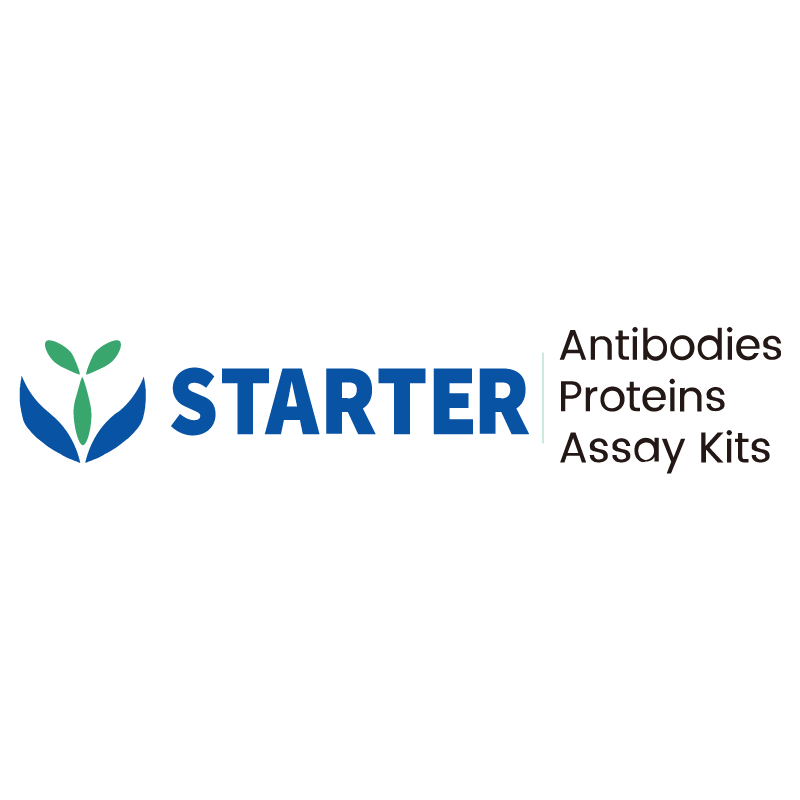WB result of Cytokeratin 6A (KRT6A) Recombinant Mouse mAb
Primary antibody: Cytokeratin 6A (KRT6A) Recombinant Rabbit mAb at 1/1000 dilution
Lane 1: A431 whole cell lysate 20 µg
Lane 2: HaCaT whole cell lysate 20 µg
Secondary antibody: Goat Anti-mouse IgG, (H+L), HRP conjugated at 1/10000 dilution
Predicted MW: 60 kDa
Observed MW: 60 kDa
Product Details
Product Details
Product Specification
| Host | Mouse |
| Antigen | Cytokeratin 6A (KRT6A) |
| Synonyms | Keratin, type II cytoskeletal 6A; Cytokeratin-6A (CK-6A); Cytokeratin-6D (CK-6D); Keratin-6A (K6A); Type-II keratin Kb6; Allergen name; Hom s 5; K6A; KRT6D |
| Location | Nucleus, Membrane |
| Accession | P02538 |
| Clone Number | SDT-3380 |
| Antibody Type | Mouse mAb |
| Isotype | IgG2a,k |
| Application | WB, IHC-P |
| Reactivity | Hu, Ms |
| Positive Sample | A431, HaCaT |
| Purification | Protein A |
| Concentration | 2 mg/ml |
| Conjugation | Unconjugated |
| Physical Appearance | Liquid |
| Storage Buffer | PBS, 40% Glycerol, 0.05% BSA, 0.03% Proclin 300 |
| Stability & Storage | 12 months from date of receipt / reconstitution, -20 °C as supplied |
Dilution
| application | dilution | species |
| WB | 1:1000-1:10000 | Hu |
| IHC-P | 1:1000 | Hu, Ms |
Background
Cytokeratin 6A (KRT6A) is a type II intermediate filament keratin that assembles with its obligatory partner keratin 16 to form robust cytoskeletal networks in stratified epithelia, especially in palmoplantar epidermis and oral mucosa, where it confers mechanical resilience under shear stress; its expression is rapidly up-regulated following injury, inflammation, or hyperproliferation via STAT3, NF-κB and MAPK signaling, and gain-of-function mutations (e.g., p.N171K) cause pachyonychia congenita with thickened nails and painful palmoplantar keratoderma, while loss-of-function variants delay wound closure and attenuate keratinocyte migration, highlighting KRT6A’s dual role in epithelial protection and pathological remodeling.
Picture
Picture
Western Blot
Immunohistochemistry
IHC shows positive staining in paraffin-embedded human tonsil. Anti-Cytokeratin 6A (KRT6A) antibody was used at 1/1000 dilution, followed by a HRP Polymer for Mouse & Rabbit IgG (ready to use). Counterstained with hematoxylin. Heat mediated antigen retrieval with Tris/EDTA buffer pH9.0 was performed before commencing with IHC staining protocol.
IHC shows positive staining in paraffin-embedded human skin. Anti-Cytokeratin 6A (KRT6A) antibody was used at 1/1000 dilution, followed by a HRP Polymer for Mouse & Rabbit IgG (ready to use). Counterstained with hematoxylin. Heat mediated antigen retrieval with Tris/EDTA buffer pH9.0 was performed before commencing with IHC staining protocol.
IHC shows positive staining in paraffin-embedded human lung squamous cell carcinoma. Anti-Cytokeratin 6A (KRT6A) antibody was used at 1/1000 dilution, followed by a HRP Polymer for Mouse & Rabbit IgG (ready to use). Counterstained with hematoxylin. Heat mediated antigen retrieval with Tris/EDTA buffer pH9.0 was performed before commencing with IHC staining protocol.
Negative control: IHC shows negative staining in paraffin-embedded human cerebral cortex. Anti-Cytokeratin 6A (KRT6A) antibody was used at 1/1000 dilution, followed by a HRP Polymer for Mouse & Rabbit IgG (ready to use). Counterstained with hematoxylin. Heat mediated antigen retrieval with Tris/EDTA buffer pH9.0 was performed before commencing with IHC staining protocol.
Negative control: IHC shows negative staining in paraffin-embedded human prostatic cancer. Anti-Cytokeratin 6A (KRT6A) antibody was used at 1/1000 dilution, followed by a HRP Polymer for Mouse & Rabbit IgG (ready to use). Counterstained with hematoxylin. Heat mediated antigen retrieval with Tris/EDTA buffer pH9.0 was performed before commencing with IHC staining protocol.
IHC shows positive staining in paraffin-embedded mouse esophagus. Anti-Cytokeratin 6A (KRT6A) antibody was used at 1/1000 dilution, followed by a HRP Polymer for Mouse & Rabbit IgG (ready to use). Counterstained with hematoxylin. Heat mediated antigen retrieval with Tris/EDTA buffer pH9.0 was performed before commencing with IHC staining protocol.


